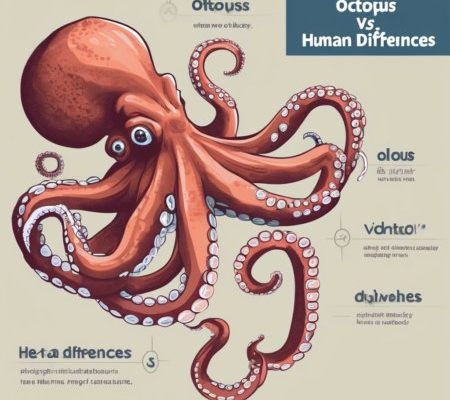![Octopus Vs. [Similar Species] - Key Differences](https://gudri.com/wp-content/uploads/2025/06/Octopus_Vs___Similar_Species______Key_Differences_image_0.jpg)
Picture this: the octopus, with its eight long, flexible arms, is a master escape artist. Then there’s the cuttlefish, which looks like it’s wearing a spaceship for a hard hat, equipped with incredible color-changing abilities. While they share a love for the sea, their differences are fascinating and worth exploring. So let’s take a look at how these two cephalopods stack up against each other.
Physical Traits: A Tale of Two Shapes
Let’s start with what you can see on the outside. The octopus and cuttlefish look quite different at first glance. An octopus boasts eight flexible arms that move with grace, allowing it to squeeze through tight spaces and explore crevices in rocks. Its body is bulbous and often soft—perfect for camouflage among the coral reef.
On the other hand, a cuttlefish has a unique, flattened body and an internal shell called the cuttlebone, which helps it maintain buoyancy. Instead of arms, it has a pair of long tentacles that it uses to catch prey swiftly. When you see a cuttlefish gliding through the water, it almost looks like a tiny alien spaceship, with fins that flutter like a bird’s wings.
Color Manipulation: Masters of Disguise
Now, here’s where things get really interesting. Both the octopus and cuttlefish have incredible abilities to change color, but they do it differently. Octopuses change their skin color and texture to blend in with their surroundings. It’s like they have a superpower for camouflage!
Cuttlefish take this a step further. They can not only change colors but also create dynamic patterns. Imagine a fashion show under the sea, with cuttlefish strutting their stuff in stripes, spots, or even shimmering colors. This ability isn’t just for show; it’s a survival tactic. By changing colors rapidly, cuttlefish can communicate with each other and confuse predators.
Behavior: Masters of Intelligence
Both of these creatures are known for their intelligence, but their behaviors highlight different strengths. Octopuses are known for their problem-solving skills. In captivity, they’ve been observed opening jars and escaping tanks. It’s like having a furry friend who knows how to unlock the pantry!
Cuttlefish, however, are experts at using their environments to their advantage. They can display complex behaviors like stalking prey and using their color-changing abilities to communicate with each other. If octopuses are the hard-working problem-solvers, cuttlefish are the stealthy spies of the ocean world. Each has its way of thriving in the underwater realm.
Feeding Habits: What’s on the Menu?
When it comes to what they eat, both octopuses and cuttlefish are carnivores, but they have different hunting styles. Octopuses are solitary hunters. They sneak up on their prey—like crabs and fish—using their stealth and intelligence to catch dinner.
Cuttlefish, in contrast, employ a more tactical approach. They often use their color-changing abilities to blend into their surroundings and ambush unsuspecting prey. It’s akin to a game of hide-and-seek where they’re the ultimate champions. Their ability to shoot out their tentacles faster than the blink of an eye makes them formidable hunters.
Reproductive Strategies: A Life Cycle Unlike Any Other
The reproductive habits of these two species also differ significantly. Octopuses have a unique approach to mating. After mating, females lay thousands of eggs and typically guard them until they hatch, often sacrificing their own lives in the process. It’s a heart-wrenching yet beautiful cycle of life.
Cuttlefish, on the other hand, display different strategies. Males often engage in elaborate displays to attract females, showcasing their color-change skills. After mating, females also lay eggs, but they are not as devoted as octopuses in guarding them. Instead, they hope their offspring can fend for themselves right from the start.
Habitat: Home Sweet Home Under the Sea
Diving into their environments, octopuses prefer rocky ecosystems and coral reefs, where they can hide from predators and find food. Their ability to blend into their surroundings makes them well-suited for such habitats. They often create dens to hang out in, using shells and rocks to make a cozy home.
Cuttlefish, however, are frequently found in sandy or muddy sea beds. They enjoy shallow waters where they can easily hunt and hide. Their bodies help them move swiftly through the sand, allowing them to ambush prey more effectively.
Final Thoughts: Celebrating Diversity in the Ocean
So, what have we learned by comparing the octopus and the cuttlefish? They both belong to the same family yet showcase distinct personalities and abilities. Octopuses charm us with their intelligence and problem-solving skills, while cuttlefish mesmerize with their dazzling color displays and unique hunting techniques.
The next time you’re enjoying a seafood dinner or watching a nature documentary, you might find yourself appreciating these incredible creatures a bit more. They remind us that even within the same family, diversity flourishes in nature, each species carving out its niche in the vast underwater world.

